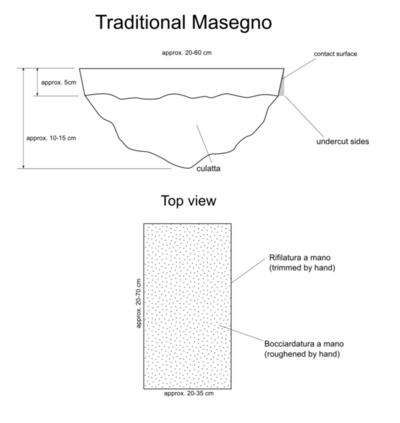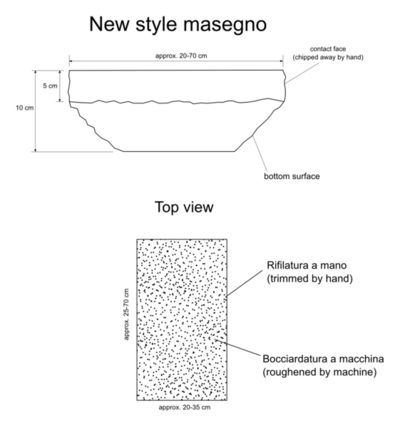Masegno
Masegni stones are the most prevalent paving stone in Venice, in fact they make up over 70% of all Venetian pavement[1]. There are two types of masegni stones used in paving Streets. Traditional masegni have been used since 1676 and hold great historical value to the city.[2] Newer masegni stones are used in some Street Pavement and are used to replace unusable traditional stones. Both stones are made from quarried Trachyte from the Euganean Hills.

Traditional
These are original stones that where first introduced in the 18th century.[3] The sides of the traditional masegno go straight down for 5cm then slant inward to the bottom of the stone, this slant allows stones to be removed much faster during Street Maintenance. (For typical traditional masegni dimensions see Paving Stones.)
New

These new stones are made from the same material as traditional masegno. New masegno are made for the purpose of replacing missing stones, or stones that are worn beyond repair.[4] The trachyte used in making these new stones is a finite resource, and as time passes it becomes harder and more expensive for Insula to acquire new stones. So new masegno are only used when they are absolutely needed. Unlike the traditional masegno, these new stones are completely rectangular, so workers need to chip off the required slanted edges before using the stones.[5] (For typical new masegni dimensions see Paving Stones.)
See Also
References
- ↑ Quaderni. Venice, Italy: Insula spa, 1999. s.v. "I"Masegni"."http://www.insula.it/index.php/quaderni/96-i-masegni-1-1999-
- ↑ G. Tassini, Curiosita Venezia, (6th edition, 1931)
- ↑ Insula SpA and Matteo Alemanno, Venice Preservation and Urban Maintenance. Venice, Italy: Grafiche Veneziane.
- ↑ Insula SpA and Matteo Alemanno, Venice Preservation and Urban Maintenance. Venice, Italy:Grafiche Veneziane.
- ↑ Ing. Lorenzo Bottazo,November 3rd 2011
Bibliography
Ing. Lorenzo Bottazzo, Nov 2011
External Links
NULL